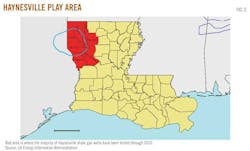LOUISIANA HAYNESVILLE SHALE—1: Characteristics, production potential of Haynesville shale wells described
Mark J. Kaiser
Yunke Yu
Louisiana State University
Baton Rouge
The contribution of the Haynesville shale to Louisiana's gas production has been phenomenal: After 3 years, almost 60% of the state's gas output is now sourced from the Haynesville (Fig. 1).
The Haynesville is the deepest, hottest, and highest pressured shale among the big four plays (the others being Barnett, Fayetteville, and Marcellus) and also the most expensive, with drilling and completion cost at $7-10 million/well. The potential rewards are great, however, with initial production averaging 10 MMcfd and expected recoveries of 2-4 bcf/well.
The purpose of this article is to describe the productivity characteristics of Haynesville wells, project future production from the inventory of active wells, and assess production potential based on hypothetical drilling scenarios. In Parts 2 and 3 of this series we will describe the operating envelope under which Haynesville wells are expected to be economic and characterize the profit space.
In this article, we offer statistical analysis of wells drilled to date and construct type profiles to characterize the play. We also compute the distribution of expected ultimate recovery per foot of perforation length.
We estimate that the current inventory of producing wells will extract 3 tcf over their life cycle, and within the next 3 years, cumulative build-out in the region will range between 3 and 9 tcf. To maintain current gas production levels in the state near-term, we estimate that about 550 shale gas wells/year will need to be completed over the next 3 years.
Geology and reservoir characteristics
The Haynesville shale is one of several unconventional gas plays that have been discovered in the US in recent years and promise to dramatically change the course of future domestic energy development.1
The Haynesville shale play covers 9,000 sq miles across East Texas and Northwest Louisiana (Fig. 2). The Haynesville was laid down during the Upper Jurassic and is overlain by the Bossier shale followed by the Cotton Valley sandstone. It is underlain by the Cotton Valley limestone in Texas and the Smackover limestone in Louisiana.2
Wells targeting the Haynesville shale are typically drilled to vertical depths of 11,000-12,500 ft and have horizontal laterals of 4,000-5,500 ft. The Haynesville is unique because of its abnormally high pressures of 0.72-0.90 psi/ft and temperatures greater than 300° F. The high reservoir pressure was created when the organic material in the shale broke down into gas but remained trapped in the source rock because of impenetrable surrounding rock layers.
Sedimentation from ancestral rivers thickened the Haynesville along the Arkansas-Louisiana line to 400 ft. To the south, the Haynesville interval thins to 180 ft through Bossier, Red River, and DeSoto parishes in Louisiana and Shelby County, Texas.3 Some sections are highly pressurized with faults, clay deposits, and other factors contributing to drilling complexity and risk. The highest-producing wells occur in an area where the interval is thin with high calcite and low clay content.4 5
Most regions are thermally mature and contain only dry gas. Through December 2010, 1.56 tcf had been extracted from the play with 20,500 bbl of condensate. Estimates of technically recoverable resources range between 73 tcf and 289 tcf, making the Haynesville one of the largest shale plays in the US.
Displaying 1/6 Page1, 2, 3, 4, 5,6Next>
View Article as Single page


